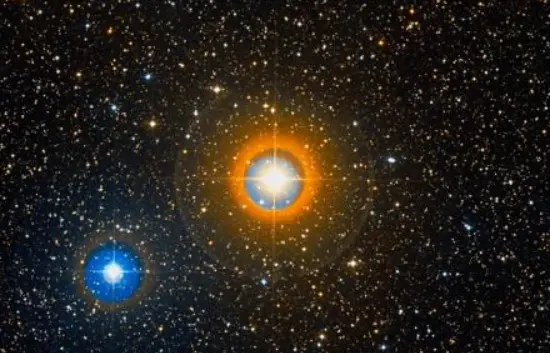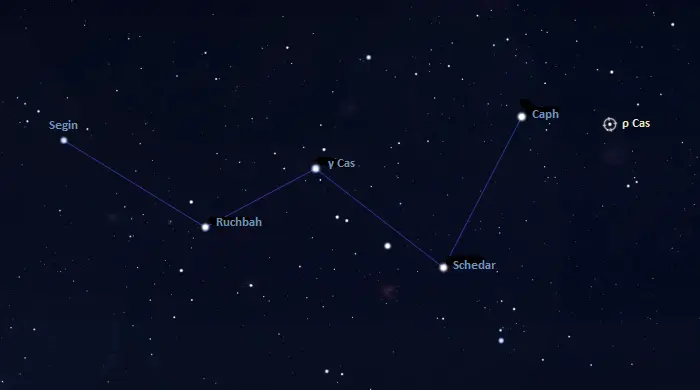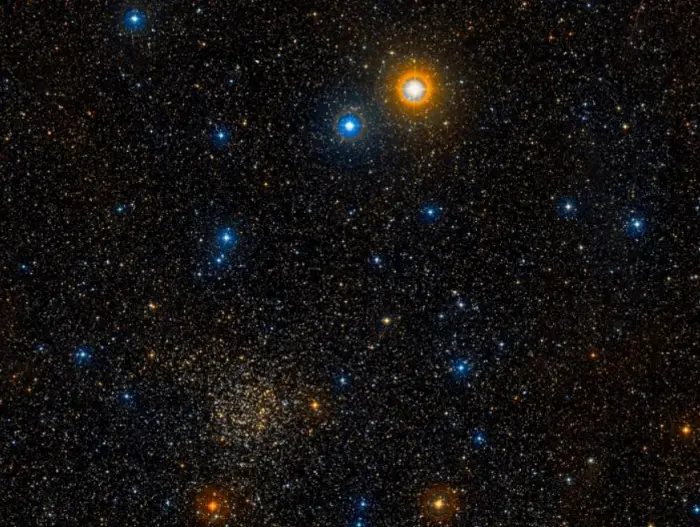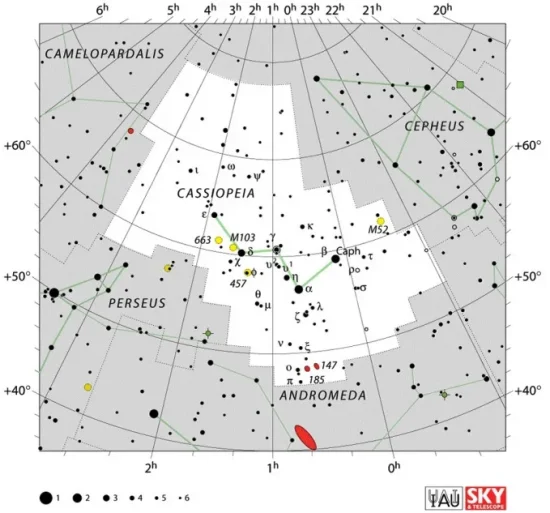Rho Cassiopeiae (ρ Cas) is a yellow hypergiant located approximately 3,425 light-years away in the northern constellation Cassiopeia. With an apparent magnitude that varies between 4.1 and 6.2, the star is visible to the unaided eye. The hypergiant is one of the most luminous stars known, with an energy output more than 300,000 times that of the Sun.
Star type
Rho Cassiopeiae is a yellow hypergiant of the spectral type G2Iae. It is a single star, without any known companions. It has a mass about 40 times that of the Sun and a radius between 636 and 981 solar radii. With a surface temperature between 4,571 and 6,044 K, Rho Cas is between 302,000 and 530,000 times more luminous than the Sun. The star has a projected rotational velocity of 25 km/s. Its estimated age is between 4 and 6 million years.

Rho Cassiopeiae, image: Wikisky
Other sources give a normal temperature of more than 7,000 K and a radius about 400 times that of the Sun. The star experiences intense outbursts about every 50 years which cause a drop in temperature and a decrease in visual brightness.
Even though it is still a very young star, Rho Cassiopeiae has already reached the final stages of its life cycle due to its high mass. It will soon develop an iron core and go out as a spectacular supernova. The star is a candidate Type II supernova progenitor.
Rho Cassiopeiae has higher surface abundances of most heavy elements than the Sun, but is low on carbon and oxygen. It has strong lines of sodium, indicating that it had experienced a dredge-up when it was a red supergiant in an earlier stage of its evolution. During the dredge-up, the products of fusion from the star’s core were transported to the surface via convection and became visible in the star’s spectrum.
Rho Cassiopeiae is now believed to be evolving towards hotter temperatures. It is fusing helium to carbon through the triple-alpha process.
Yellow hypergiants are exceptionally rare. Only a few dozen of these massive, luminous stars have been discovered in the Milky Way. However, Rho Cassiopeiae is not the only known yellow hypergiant in Cassiopeia. The constellation is also home to the slightly fainter and more distant V509 Cassiopeiae, which shines at magnitude 4.6 – 6.1 from an approximate distance of 15,688 light-years.
Unlike post-red supergiants, which are unstable because of their relatively low mass and high luminosity, yellow hypergiants are warmer and experience small and irregular pulsations which sometimes bring about larger outbursts due to the instability of the stars’ outer layers.
The combination of brightness and temperature places yellow hypergiants in the Yellow Evolutionary Void, a part of the Hertzsprung-Russell diagram where stars become highly unstable and experience immense mass loss before evolving toward the blue supergiant phase.
Brightness
On average, Rho Cassiopeiae is the 14th brightest star in Cassiopeia. The star is visible to the unaided eye even though it lies more than 3,400 light-years away. If it were not dimmed by interstellar dust, it would be two magnitudes brighter.
Mass
Rho Cassiopeiae has a mass about 40 times that of the Sun. The star normally experiences mass loss at a rate of about 10-6 solar masses per year. However, during outbursts, the mass loss rate has been observed to jump to 5×10-2 solar masses per year. This corresponds to about 3% of a solar mass or 10,000 Earth masses a year.
Size
Rho Cassiopeiae has a radius between 636 and 981 times that of the Sun. Other estimates place it in the range from 400 to 500 solar radii, which is twice the size of the Earth’s orbit or about 627 million kilometres. If it took the Sun’s place in our own solar system, the star would extend beyond the orbit of Mars.
Even though it is a behemoth, Rho Cas is not one of the largest stars known. The current record holder Stephenson 2-18 has an estimated radius of 2,150 solar radii, well above the theoretical limit of star size (around 1,500 R☉). The red supergiants VY Canis Majoris and AH Scorpii have radii of 1,420 and 1,411 R☉, while WOH G64 in the Large Magellanic Cloud has a radius about 1,540 times that of the Sun.
The estimated radius of Rho Cas is comparable to those of Betelgeuse and Antares, the brightest red supergiants in the sky. Betelgeuse has a radius between 764 and 1,021 R☉ and Antares, around 680 R☉.
Luminosity
Rho Cassiopeiae is one of the most luminous stars known. It has an average absolute magnitude of -9.5 and an estimated luminosity between 302,000 and 530,000 times that of the Sun. Most of the star’s energy output is in the visible part of the spectrum. During the larger outbursts, the luminosity stays constant but the output shifts towards the infrared part of the spectrum.
In comparison, some of the most luminous stars known have luminosities several million times that of the Sun. The Wolf-Rayet stars BAT99-98 and R136a1 in the Large Magellanic Cloud have luminosities of 5,000,000 and 4,677,000 L☉, while the current record holder, Godzilla star in the gravitationally lensed Sunburst galaxy discovered in 2022, has an estimated luminosity between 134,000,000 and 255,000,000 times that of the Sun.
Rho Cassiopeiae is close to the Eddington luminosity limit. It loses mass at a rate of about 10-6 M☉/yr through a stellar wind hundreds of millions of times stronger than the solar wind.
The Eddington limit is the maximum luminosity a star can achieve while in hydrostatic equilibrium. Once it exceeds this limit, it triggers an intense radiation-driven stellar wind from its outer layers.
Variability
Rho Cassiopeiae was first documented as a variable star in a 1901 study led by Edward Charles Pickering. It was described only as “pec” but its small range of variation was noted by Pickering and his team. The nature of the star’s variability was uncertain.
In 1946, the hypergiant reached a deep visual minimum, dropping from magnitude 4.5 to 6th magnitude. This was accompanied by a drop in temperature of more than 3,000 K. Astronomers believed this was related to the discovery of an expanding shell around the star. At the time, Rho Cassiopeiae was classified as an F8-class star.
In a 1953 study, astronomer Wallace R Beardsley noted spectral lines that are typically found in M-type supergiants, based on observations carried out at the McDonald Observatory (University of Texas) and the Yerkes Observatory in Wisconsin. The star returned to normal brightness in 1947. A similar event was documented in 1893, suggesting that the star experiences eruptions once every 50 years.
The nature of the variability in Rho Cassiopeiae was eventually explained as caused by pulsations and mass loss. Like other evolved, exceptionally massive stars, Rho Cassiopeiae is highly unstable and is experiencing a high degree of mass loss. It is occasionally obscured by the expelled material.
A 1986 study authored by Yaron Sheffer and David L. Lambert studied high-resolution spectra of Rho Cas and found a semiregular variation of the star’s atmosphere. The astronomers found a dominant radial pulsation mode with a period of about 520 days. They suggested that the star is now evolving from the red supergiant stage toward the blue and may evolve into a Wolf-Rayet star in about 7,000 years.
More recently, Rho Cassiopeiae had an outburst in 2000-2001. Its brightness dimmed by about a magnitude between June and September 2000 and returned to normal by April 2001. Outburst spectra obtained with the Utrecht Echelle Spectrograph on the William Herschel Telescope in the near-infrared revealed that the star’s effective temperature had decreased by at least 3,000 K and a low-temperature, optically thick circumstellar gas shell was formed over a period of 200 days. The formation of the shell was caused by the dynamic instability of the star’s upper atmosphere. The team that conducted the study, which included A. Lobel, A. K. Dupree, R. P. Stefanik and G. Torres, found that the mass loss rate during the outburst was comparable to the rate proposed for Eta Carinae during outbursts.
Another outburst was observed in 2013. The shell ejection was accompanied by a brightness decrease of 0.6 magnitudes and a temperature drop of about 3,000 kelvin.
Facts
Rho Cassiopeiae was once believed to be about 10,000 light-years away, which would have made it one of the most distant stars visible to the unaided eye. The distance was given by Lobel et al. in 2003 based on the original Hipparcos parallax, which was smaller than the currently accepted one and has since been corrected.
Name
Rho Cassiopeiae (pronunciation: (/ˌroʊ kæsiəˈpiːaɪ) does not have a proper name. The Bayer designation Rho Cassiopeiae (ρ Cassiopeiae) was first used in German uranographer Johann Bayer’s star catalogue Uranometria (1603). The Flamsteed designation 7 Cassiopeiae comes from the star catalogue published by the English astronomer John Flamsteed in 1712.
In Chinese astronomy, Rho Cassiopeiae was known as 螣蛇十二 (Téng Shé shíèr), the Twelfth Star of Flying Serpent. Flying Serpent was an asterism formed by 22 stars: Alpha Lacertae, 4 Lacertae, Pi2 Cygni, Azelfafage (Pi1 Cygni), stars 5 and 6 (uncertain), HD 206267, 13 Cephei, Epsilon Cephei, Beta Lacertae, Sigma Cassiopeiae, Rho Cassiopeiae, Tau Cassiopeiae, AR Cassiopeiae, 9 Lacertae, 3 Andromedae, 7 Andromedae, 8 Andromedae, Lambda Andromedae, Psi Andromedae, Kappa Andromedae, and Iota Andromedae. The faint asterism was part of the Encampment mansion, one of the northern mansions of the Black Tortoise.
Location
Rho Cassiopeiae lies in the southwestern part of Cassiopeia. It is relatively easy to find because it appears near Cassiopeia’s W, one of the most recognizable asterisms in the northern sky. The star can be found southwest of Caph, the rightmost star of the W.

The location of the yellow hypergiant Rho Cassiopeiae, image: Stellarium
Rho Cassiopeiae appears just north of the open cluster NGC 7789. Also known as Caroline’s Rose or the White Rose Cluster, NGC 7789 is easily observed in binoculars and small telescopes. It has an apparent magnitude of 6.7 and stretches across 16 arcminutes of the apparent sky. The cluster was discovered by the German-born British astronomer Caroline Herschel in 1783. It lies approximately 7,600 light-years away. It is also catalogued as Collinder 460 and Melotte 245.

Rho Cassiopeiae and the White Rose Cluster (NGC 7789), image: Wikisky
Constellation
Rho Cassiopeiae is located in the constellation Cassiopeia. Cassiopeia is one of the Greek constellations, catalogued by the Greek astronomer Ptolemy in his Almagest in the 2nd century CE. In Greek mythology, it is associated with Cassiopeia, Queen of Aethiopia and mother of Andromeda.
Cassiopeia is one of the most identifiable constellations in the northern sky. Its five brightest stars form a distinctive W in the sky that is easily visible even from light-polluted areas. For northern observers, the constellation is visible throughout the year, but it never rises very high above the horizon from locations south of the equator.

Cassiopeia constellation map by IAU and Sky&Telescope magazine
Cassiopeia hosts many notable stars. These include the constellation’s luminary Schedar (Alpha Cassiopeiae), an orange giant located 228 light-years away, the variable yellow-white giant Caph (Beta Cassiopeiae), the hot eruptive variable Gamma Cassiopeiae, a prototype for a class of stars known as the Gamma Cassiopeiae variables, and the yellow dwarf Achird (Eta Cassiopeiae), located only 19.32 light-years away.
The constellation is also home to the hot blue variable supergiant Kappa Cassiopeiae, the yellow-white supergiant Phi Cassiopeiae, the yellow hypergiant V509 Cassiopeiae, the white hypergiant 6 Cassiopeiae, and the eclipsing variable star AO Cassiopeiae (Pearce’s Star), composed of two hot O-type stars.
Cassiopeia contains several bright deep sky objects. These include the open clusters Messier 52, Messier 103, the Owl Cluster (NGC 457), and Caroline’s Rose Cluster (NGC 7789), the vast neighbouring Heart and Soul nebulae (IC 1805 and IC 1848) with the smaller Fish Head Nebula (IC 1795), the emission nebulae NGC 7635 (the Bubble Nebula) and NGC 281 (the Pacman Nebula), and the irregular galaxy IC 10, a member of the Local Group. The constellation also hosts the planetary nebula known as the Shrimp Nebula (Sh2-188) and the supernova remnants Cassiopeia A, the Medulla Nebula, and Tycho’s Star (3C 10).
The best time of the year to see the stars and deep sky objects of Cassiopeia is during the month of November, when the constellation appears high above the horizon in the evening. The entire constellation can be seen from locations north of the latitude 20° S.
The 10 brightest stars in Cassiopeia are Schedar (Alpha Cas, mag. 2.240), Caph (Beta Cas, mag. 2.25–2.31), Tiansi (Gamma Cas, mag. 1.6 – 3.0), Ruchbah (Delta Cas, mag. 2.68), Segin (Epsilon Cas, mag. 3.37), Achird (Eta Cas, mag. 3.44), Fulu (Zeta Cas, mag. 3.59–3.68), 50 Cassiopeiae (mag. 3.95), Cexing (Kappa Cas, mag. 4.12–4.21), and Theta Cassiopeiae (mag. 4.334).
Rho Cassiopeiae
| Spectral class | G2Iae (F8pIa-K0pIa-0) |
| Variable type | Semiregular variable (SRd) |
| U-B colour index | 1.15 |
| B-V colour index | 1.26 |
| Apparent magnitude | 4.1 – 6.2 |
| Absolute magnitude | -9.5 |
| Distance | 3,425 ± 652 light-years (1,050 ± 210 parsecs) |
| Parallax | 0.9470 ± 0.2021 mas |
| Radial velocity | -47 km/s |
| Proper motion | RA: -4.699 ± 0.086 mas/yr |
| Dec.: −3.45 ± 0.080 mas/yr | |
| Mass | 40 M☉ |
| Luminosity | 302,000 – 530,000 L☉, 129,000 L☉ |
| Radius | 636 – 981 R☉ |
| Temperature | 4,571 – 6,044 K |
| Metallicity | 0.3 dex |
| Age | 4 – 6 km/s |
| Rotational velocity | 25 km/s |
| Surface gravity | 0.1 cgs |
| Constellation | Cassiopeia |
| Right ascension | 23h 54m 23.0325302520s |
| Declination | +57° 29′ 57.774737400″ |
| Names and designations | Rho Cassiopeiae, ρ Cas, 7 Cassiopeiae, HD 224014, HR 9045, HIP 117863, FK5 899, SAO 35879, BD+56°3111, AG+57 1709, GC 33160, GCRV 14955, IRAS 23518+5713, 2MASS J23542302+5729578, JP11 3656, PLX 5775.00, PPM 42338, TYC 4009-2605-1, UBV 21544, AAVSO 2349+56, Gaia DR2 1998148532776177664, Gaia DR3 1998148532777850880 |